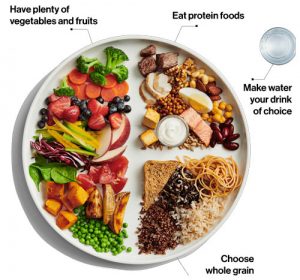
Canada’s Food Guide has played a role in how Canadians eat for as long as I can remember, which makes sense since it’s been a part of Canadians’ lives since 1942. It was first introduced to help prevent nutritional deficiencies and improve the health of Canadians.
Until 1961 the Food Guide was known as Canada’s Food Rules, which I’m sure gave many Canadians the impression they better follow it, or else. At this time the document’s name changed from Rules to Guide and offered more flexibility within the guidelines of the five original categories that were covered: milk, fruits, vegetables, meat and fish, and cereals and breads.
The most drastic change to the food guide came in 1977, with not only the content changing, but the physical look changing from a tiered format to a circular one that in many minds represented a plate.
The five categories were reduced to four to include fruits and vegetables combined, milk and milk products, grains and cereals, and meat and alternatives, helping to promote more flexibility for the increasing population and diverse food choices available.
A second page was also added which offered information on portions per day and portion sizing, as well as suggestions on food items to choose. This new version was truly seen as a teaching tool to guide Canadians to a healthier life.
The Guide was introduced into the educational curriculum to help develop the mindset of healthy living from an early age. Small changes have been made since 1977 but nothing significant, until this year. This latest version of Canada’s Food Guide is full of controversy and has plenty of people up in arms about its content.
From dairy and livestock farmers, nutritional researchers and professors, to manufacturing giants, they all have something to say about the message that this new guide is sending. And it’s not all positive.
The new guide now has the categ ories broken down into three sections with fruits and vegetables taking up 50 per cent of the pie. Dairy has now been lumped in with protein, which also includes meat, fish, eggs and legumes. This weighs in at 25 per cent, as does the whole grain segment. Water has replaced milk as the drink of choice.
ories broken down into three sections with fruits and vegetables taking up 50 per cent of the pie. Dairy has now been lumped in with protein, which also includes meat, fish, eggs and legumes. This weighs in at 25 per cent, as does the whole grain segment. Water has replaced milk as the drink of choice.
The new Food Guide also cautions about food marketing, tells us to limit foods high in sugar, salt and saturated fats, and to cook at home more.
So, what does all this mean for us in the golf business? Are we, or will we be affected by the new Food Guide? I believe the answer is yes. In some way or another we have been influenced by the Guide up until now. Take something as simple as our plate composition. When was the last time you worked on a new main course menu item and didn’t think protein, starch, veg?
Now, I’m not suggesting that because of the new Guide 90 per cent of your membership is going to start demanding that vegetables be the focal point of all your main courses, or that you have to eliminate burgers, wings and fish and chips. However, with the amount of publicity this new Guide is getting – both good and bad – there are going to be more and more people looking for healthier options.
If we take the time now to look at how we can develop our menus to offer more “home- made”, non-processed items, as well as veggie-focused meals, we can maybe entice more of our guests to stay at the club and eat items they know they should be eating but have no time or interest in making.
If done right, we may even be able to capitalize on the Food Guide’s press and show our guests that when developing our menus, we have their best interests in mind. I am not saying you need to recreate the wheel when it comes to your menu. The best way to go about it is to use a combination of tactics – review, enhance, replace and add items, if necessary.
Prior to assessing your menu make sure you are confident of the demographics you are trying to feed. When was the last time you changed your menu? I mean gave it a real overhaul. People’s eating habits change and a good question to ask is if your menu has been changing with them.
This new Food Guide is telling us how we should be eating, but the reality is many of your customers may already be eating this way.
Did you know that nearly 10 per cent of Canadians consider themselves either vegan or vegetarian? Surprised? I know I was, but this number has been climbing steadily since 2003, and with the majority of these people being under the age of 35, this number is more than likely only going to get larger.
We will see menus grow over the next 10 years to reflect a healthy, healthier and healthiest array of options to feed this ever-growing population. Understand this is a time of transition; we are not going to jump all in and change our menus to reflect this new Food Guide, per se. However, what we should be doing is using it for what it was originally intended for: a guide.
To get started, take a look at the dogs of your menu, ones that neither sell nor make money. No brainer. These should go to help make room for some new “healthier” items. Now look at your menu again and see how you can make the items that are left more in tune with a healthier offering. Maybe it’s as simple as adding a more substantial veggie and dip side with your wings, or offering your sandwiches on whole grain bread, or for the meats you put in those sandwiches to be roasted in house instead of purchasing processed roast beef, turkey and chicken.
Perhaps offer options for sides versus automatically giving a starch side. Give your guests that option for doubling up on the veggies or choosing a salad and a veg for sides instead of fries.
For additions to the menu, you might want to start by offering specials that have different plant-based proteins to see what options really have an appeal. Add some items to each of your menu segments. Breakfast could see the addition of smoothie bowls and a vegan scramble.
The halfway house could offer veggie wraps, falafels and even veggie dogs on their menu. Your main menu could feature more meal sized salads, veggie burgers, grilled veggie stuffed peppers, or portobellos.
You get the picture – just a larger focus on fruits, veggies and legumes, as dictated by the Food Guide. Yes, the costs will be higher, but the individuals who are determined to eat healthier are well aware of the costs associated with the decision, and critics of the new Food Guide have made it clear that this is a reality.
So, whether you agree or disagree with the shift our new Canadian Food Guide has taken, the way I see it, it’s in your club’s best interest to get a jump on offering your members a helping hand in becoming healthier Canadians.











